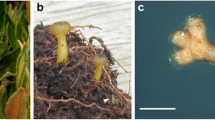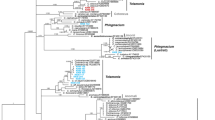Abstract
Sebacina (Sebacinales) forms ectomycorrhiza, arbutoid, ericoid, jungermannioid, cavendishioid and orchid mycorrhiza with diverse plant species. The woody plant Comarostaphylis arbutoides (Ericaceae) forms arbutoid mycorrhiza with Leccinum monticola. However, further morphotypes have hitherto not been described. C. arbutoides grows in tropical Central America at an elevation of 2,500–3,430 m a.s.l., where it is found as understory vegetation in forests or forms extensive thickets. It shares ectomycorrhizal fungi with Quercus species, thereby being a refuge for these fungi after forest clearance of the oaks. We collected arbutoid mycorrhizas of C. arbutoides from the Cerro de la Muerte (Cordillera de Talamanca) in Costa Rica, where it grows together with Quercus costaricensis. Sebacina sp. was identified after sequencing the internal transcribed spacer (ITS) and large subunit (LSU) rDNA regions, and their phylogenetic analyses. The morphotype Sebacina sp.-C. arbutoides was described morphologically and anatomically.





Similar content being viewed by others
References
Agerer R (1987–2012) Colour atlas of ectomycorrhizae. 1st–15th delivery, Einhorn, Schwäbisch Gmünd
Agerer R (1991) Characterization of ectomycorrhiza. In: Norris JR, Read DJ, Varma AK (eds) Methods in microbiology, vol 23, Techniques for the study of mycorrhiza. Academic, London, pp 25–74
Agerer R (2001) Exploration types of ectomycorrhizae—a proposal to classify ectomycorrhizal mycelial systems according to their patterns of differentiation and putative ecological importance. Mycorrhiza 11:107–114
Agerer R, Rambold G (2004–2013) DEEMY—an information system for characterization and determination of ectomycorrhizae. München, Germany. http://www.deemy.de. Accessed 25 June 2013
Azul AM, Agerer R, Freitas H (2006) “Quercirhiza dendrohyphidiomorpha” + Quercus suber L. In: Agerer L, Danielson RM, Egli S, Ingleby K, Luoma D, Treu R (eds) Descriptions of ectomycorrhizae, vol 9/10. Einhorn, Schwäbisch Gmünd, pp 87–91
Bandoni RJ (1984) The Tremellales and Auriculariales: an alternative classification. Trans Mycol Soc Jpn 25:489–530
Bidartondo MI (2005) The evolutionary ecology of myco-heterotrophy. New Phytol 167:335–352
Blaalid R, Carlson T, Kumar S, Halvorsen R, Ugland KI, Fontana G, Kauserud H (2012) Changes in the root-associated fungal communities along a primary succession gradient analysed by 454 pyrosequencing. Mol Ecol 21:1897–1908
Brevik A, Moreno-Garcia J, Wenelczyk J, Blaalid R, Eidesen PB, Carlson T (2010) Diversity of fungi associated with Bistorta vivipara (L.) Delarbre root systems along a local chronosequence on Svalbard. Agarica 29:15–26
Dearnaley JDW, Martos F, Selosse M-A (2012) Orchid mycorrhizas: molecular ecology, physiology, evolution and conservation aspects. In: Hock B (ed) Fungal associations, 2nd edn. Springer, Berlin, pp 207–230
den Bakker HC, Zuccarello GC, Kuyper TW, Noordeloos ME (2004) Evolution and host specificity in the ectomycorrhizal genus Leccinum. New Phytol 163:201–215
Freeman CC, Hinds HR (2005) Bistorta. In: Flora of North America Editorial Committee (ed) Flora of North America North of Mexico, vol 5, 33rd edn. Oxford University, New York, pp 594–597
Gardes M, Bruns TD (1993) ITS primers with enhanced specificity for basidiomycetes—application to the identification of mycorrhizae and rusts. Mol Ecol 2:113–118
Garnica S, Riess K, Bauer R, Oberwinkler F, Weiß M (2012) Phylogenetic diversity and structure of sebacinoid fungi associated with plant communities along an altitudinal gradient. FEMS Microbiol Ecol 83:265–278
Hagerman SM, Sakakibara SM, Durall DM (2001) The potential for woody understory plants to provide refuge for ectomycorrhizal inoculum at an interior Douglas-fir forest after clear-cut logging. Can J For Res 31:711–721
Halling RE, Mueller GM (2003) Leccinum (Boletaceae) in Costa Rica. Mycologia 95:488–499
Halling RE, Mueller GM (2004) Common mushrooms of the Talamanca mountains, Costa Rica. New York Botanical Garden, New York, p 195
Kagawa A, Fujiyoshi M, Tomita M, Masuzawa T (2006) Mycorrhizal status of alpine plant communities on Mt Maedake Cirque in the Japan South Alps. Polar Biosci 20:92–102
Katoh K, Misawa K, Kuma K, Miyata T (2002) MAFFT: a novel method for rapid multiple sequence alignment based on fast Fourier transform. Nucleic Acids Res 30:3059–3066
Kõljalg U, Larsson K-H, Abarenkov K, Nilsson RH, Alexander IJ, Eberhardt U, Erland S, Høiland K, Kjøller R, Larsson E, Pennanen T, Sen R, Taylor AFS, Tedersoo L, Vrålstad T, Ursing BM (2005) UNITE: a database providing web-based methods for the molecular identification of ectomycorrhizal fungi. New Phytol 166:1063–1068
Kottke I, Beiter A, Weiß M, Haug I, Oberwinkler F, Nebel M (2003) Heterobasidiomycetes form symbiotic associations with hepatics: Jungermanniales have sebacinoid mycobionts while Aneura pinguis (Metzgeriales) is associated with a Tulasnella species. Mycol Res 107:957–968
Leberecht M, Polle A, Agerer R (2012) “Fagirhiza inflata” + Fagus sylvatica L. In: Agerer L, Danielson RM, Egli S, Ingleby K, Luoma D, Treu R (eds) Descriptions of ectomycorrhizae, vol 13. Einhorn, Schwäbisch Gmünd, pp 39–43
Massicotte HB, Melville LH, Molina R, Peterson L (1993) Structure and histochemistry of mycorrhizae synthesized between Arbutus menziesii (Ericaceae) and two basidiomycetes, Pisolithus tinctorius (Pisolithaceae) and Piloderma bicolor (Corticiaceae). Mycorrhiza 3:1–11
Massicotte HB, Melville LH, Peterson RL, Luoma DL (1998) Anatomical aspects of field ectomycorrhizas on Polygonum viviparum (Polygonaceae) and Kobresia bellardii (Cyperaceae). Mycorrhiza 7:287–292
Molina R, Trappe JM (1982a) Lack of mycorrhizal specificity by the ericaceous hosts Arbutus menziesii and Arctostaphylos uva-ursi. New Phytol 90:495–509
Molina R, Trappe JM (1982b) Patterns of ectomycorrhizal host specificity and potential among Pacific Northwest conifers and fungi. Forest Sci 28:423–458
Moncalvo J-M, Lutzoni FM, Rehner SA, Johnson J, Vilgalys R (2000) Phylogenetic relationships of agaric fungi based on nuclear large subunit ribosomal DNA sequences. Syst Biol 49:278–305
Mühlmann O, Bacher M, Peintner U (2008) Polygonum viviparum mycobionts on an alpine primary successional glacier forefront. Mycorrhiza 18:87–95
Münzenberger B, Kottke I, Oberwinkler F (1992) Ultrastructural investigations of Arbutus unedo-Laccaria amethystea mycorrhiza synthezised in vitro. Trees 7:40–47
Oberwinkler F (1964) Intrahymeniale Heterobasidiomyceten. Fruchtkörperlose Sebacina-Sippen und ihre systematische Stellung. Nova Hedwigia 7:489–498
Oberwinkler F, Riess K, Bauer R, Selosse M-A, Weiß M, Garnica S, Zuccaro A (2013) Enigmatic Sebacinales. Mycol Prog 12:1–27
Osmundson TW, Halling RE, den Bakker H (2007) Morphological and evidence supporting an arbutoid mycorrhizal relationsphip in the Costa Rican páramo. Mycorrhiza 17:217–222
Richard F, Millot S, Gardes M, Selosse M-A (2005) Diversity and specificity of ectomycorrhizal fungi retrieved from an old-growth Mediterranean forest dominated by Quercus ilex. New Phytol 166:1011–1023
Riess K, Oberwinkler F, Bauer R, Garnica S (2013) High genetic diversity at the regional scale and possible speciation in Sebacina epigaea and S. incrustans. BMC Evol Biol 13:102
Ronikier M, Mleczko P (2006) Observations on the mycorrhizal status of Polygonum viviparum in the Polish Tatra Mts. (Western Carpathians). Acta Mycol 41:209–222
Ronquist F, Teslenko M, van der Mark P, Ayres DL, Darling A, Höhna S, Larget B, Liu L, Suchard MA, Huelsenbeck JP (2012) MrBayes 3.2: efficient Bayesian phylogenetic inference and model choice across a large model space. Syst Biol 61:539–542
Schoch CL, Seifert KA, Huhndorf S et al (2012) Nuclear ribosomal internal transcribed spacer (ITS) region as a universal DNA barcode marker for fungi. P Natl Acad Sci USA 109:6241–6246
Selosse M-A, Bauer R, Moyersoen B (2002a) Basal hymenomycetes belonging to the Sebacinaceae are ectomycorrhizal on temperate deciduous trees. New Phytol 155:183–195
Selosse M-A, Weiß M, Jany J-L, Tillier A (2002b) Communities and populations of sebacinoid basidiomycetes associated with the achlorophyllous orchid Neottia nidus-avis (L.) L.C.M.Rich. and neighbouring tree ectomycorrhizae. Mol Ecol 11:1831–1844
Selosse M-A, Setaro S, Glatard F, Richard F, Urcelay C, Weiß M (2007) Sebacinales are common mycorrhizal associates of Ericaceae. New Phytol 174:864–878
Selosse M-A, Dubois M-P, Alvarez N (2009) Do Sebacinales commonly associate with plant roots as endophytes? Mycol Res 113:1062–1069
Setaro S, Weiß M, Oberwinkler F, Kottke I (2006) Sebacinales form ectendomycorrhizas with Cavendishia nobilis, a member of the Andean clade of Ericaceae, in the mountain rain forest of southern Ecuador. New Phytol 169:355–365
Smith SE, Read DJ (2008) Mycorrhizal symbiosis, 3rd edn. Academic, Amsterdam, p 787
Spurr AR (1969) A low-viscosity epoxy resin embedding medium for electron microscopy. J Ultrastruct Res 26:31–43
Stamatakis A (2006) RAxML-VI-HPC: maximum likelihood-based phylogenetic analyses with thousands of taxa and mixed models. Bioinformatics 22:2688–2690
Stamatakis A, Hoover P, Rougemont J (2008) A rapid bootstrap algorithm for the RAxML web servers. Syst Biol 57:758–771
Urban A, Weiß M, Bauer R (2003) Ectomycorrhizas involving sebacinoid mycobionts. Mycol Res 107:3–14
Wei J, Agerer R (2011) Two sebacinoid ectomycorrhizae on Chinese pine. Mycorrhiza 21:105–115
Weiß M, Oberwinkler F (2001) Phylogenetic relationships in Auriculariales and related groups—hypotheses derived from nuclear ribosomal DNA sequences. Mycol Res 105:403–415
Weiß M, Selosse M-A, Rexer K-H, Urban A (2004) Sebacinales: a hitherto overlooked cosm of heterobasidiomycetes with a broad mycorrhizal potential. Mycol Res 108:1003–1010
Weiß M, Sýkorová Z, Garnica S, Riess K, Martos F, Krause C, Oberwinkler F, Bauer R, Redecker D (2011) Sebacinales everywhere: previously overlooked ubiquitous fungal endophytes. PLoS One 6:e16793
Wells K, Oberwinkler F (1982) Tremelloscypha gelatinosa, a species of a new family Sebacinaceae. Mycologia 74:325–331
White TJ, Bruns TD, Lee SB, Taylor JW (1990) Amplification and direct sequencing of fungal ribosomal RNA genes for phylogenetics. In: Innis MA, Gelfand DH, Sninsky JN, White TJ (eds) PCR Protocols: a guide to method and applications. Academic, San Diego, pp 315–322
Wright MM, Cross R, Cousens RD, May TW, McLean CB (2010) Taxonomic and functional characterization of fungi from the Sebacina vermifera complex from common and rare orchids in the genus Caladenia. Mycorrhiza 20:375–390
Zak B (1976a) Pure culture synthesis of Pacific madrone ectendomycorrhizae. Mycologia 68:362–369
Zak B (1976b) Pure culture synthesis of bearberry mycorrhizae. Can J Bot 54:1297–1305
Acknowledgments
The authors are indebted to the German Research Foundation (DFG) for funding this project (Mu 1035/15-1). We thank Prof. Agerer for his help with studying mycorrhizas. We are grateful to Monika Roth for excellent technical assistance. We also thank Federico Valverde and Silvia Lobo Cabezas for their assistance in the cloud forests of Costa Rica, and Mary Lavin-Zimmer from the German Research Centre (GFZ) for English corrections.
Author information
Authors and Affiliations
Corresponding author
Rights and permissions
About this article
Cite this article
Kühdorf, K., Münzenberger, B., Begerow, D. et al. Sebacina sp. is a mycorrhizal partner of Comarostaphylis arbutoides (Ericaceae). Mycol Progress 13, 733–744 (2014). https://doi.org/10.1007/s11557-013-0956-9
Received:
Revised:
Accepted:
Published:
Issue Date:
DOI: https://doi.org/10.1007/s11557-013-0956-9




